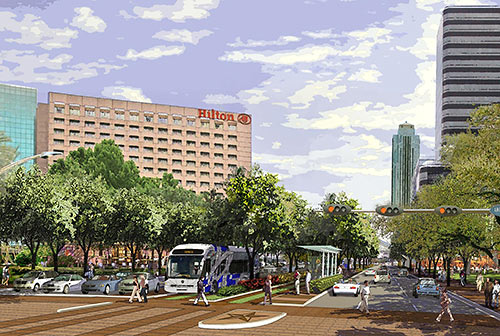Here’s one guy who doesn’t like the idea.
Ridership models developed by the Uptown TIRZ board project that the new bus route will carry 10,000 riders per day in 2018. This estimate is outrageously inflated, given that the more than 30-year-old Park & Ride system only carries 16,000 riders per day, most of whom are downtown-bound. This has been tried before. Since 1985, Metro has rolled out seven Park & Ride routes to the Galleria. Last month, they cancelled the sixth route (Kingsland to NW Transit to Uptown) due to low ridership. The sole surviving Park & Ride route to the Galleria (Kuykendahl to Greenway to Uptown) is classified as “poor-performing,” carrying an average of only 220 people per day to both districts.
Major Galleria-area employer Apache, initially in favor of the project, now opposes it. The company surveyed its employees and asked how many would drive to the Northwest Mall and then board a bus to the Post Oak Central offices. Not one Apache employee was interested in doing so. Not one. Why has there never been a well-reasoned, comprehensive survey of Galleria employees as to their expected usage of such a project?
Parking in the Galleria is convenient, readily available and reasonably affordable. This is the complete opposite of the downtown area. Even in the parking-challenged downtown, over the past five years, Park & Ride participation rates are falling, from 38 percent to 28 percent. Metro’s entire Park & Ride system consists of 29 lots. Despite a 30 year-plus operating history, 23 of its 29 lots operate at 55 percent or less of capacity.
What will this Guide Way project do to Post Oak, Houston’s Rodeo Drive? I believe it will ruin it. Look what happened to the merchants on Main Street. Look what’s happened to the Central Business District regarding crosstown traffic.
[…]
Uptown, Metro and the city are talking about condemnation proceedings taking place before a final plan has been produced. This is par for the course. Another example of Metro’s “Ready. Fire. Aim.” approach: Recently, a long-known environmental hazard interrupted construction of the Harrisburg Line of light rail. Believe it or not, the meandering East Side Metro trains don’t run the full length of the Harrisburg route. When did the poor planning method become an accepted standard?
I am convinced that people decide to work and (increasingly) live in the Galleria area due to the ease of access to retail, including restaurants and grocery stores. Completely dedicated bus lanes/guide ways make no sense to any student of public transportation unless they are of the BRT (bus rapid transit) variety. These lanes are definitely not, despite having been initially designated as such. BRT lanes are dedicated and do not stop for traffic.
The piece is such a mishmash of unsourced assertions, tangents, and failure to address items that have already been raised during the process that it’s hard to know where to begin. The main thing to me is that nowhere does the author suggest any alternatives to the BRT line as a way of dealing with Uptown’s crushing traffic congestion. I came away with the impression that his preference is to do nothing because there is no problem to be solved. I don’t even know how to respond to that, so let me just state a few basic principles. Traffic is bad. It’s a problem now, and it will limit future growth and economic opportunities. Building more road capacity, especially non-highway road capacity, is not an option to alleviate the mobility issues we have now or the ones we will continue to have if we do nothing. The best way to create more capacity is to create options for people who could get where they need to go without using their car. This means mass transit, bike trails and lanes, better and safer sidewalks, and the like. Not everyone will use these things, maybe not even a majority of people. But many people will use at least one of these options at least some of the time, and every time they do it means less traffic for those who can’t or won’t do anything other than drive. Maybe this plan isn’t the best of all possible plans. I’m sure there are ways it could feasibly be better, and I have no doubt there will be implementation and operation problems to deal with. But it is a workable plan that addresses the main issue, that there isn’t enough room for all the cars that want to be in Uptown now, let alone the ones that will want to be there in the future. If you want to argue against it, I’d appreciate it if you came up with your own workable alternative to it.


Charles, today’s Chron has 2 op/eds – one for, one against the BRT.
I do remember how Main street suffered with building the light rail, and I don’t wish this on Post Oak.
And if I read the pro-BRT one correctly, that one TIRZ alone gets $33M of our tax dollars.
Looks like getting rid of TIRZ’s would fix the City’s budget woes.